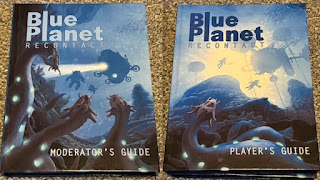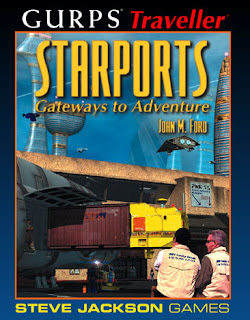This review was originally posted on RPG.net by myself on 30 September 2000. I'm adding a copy here to preserve it for posterity. GURPS Traveller Starports (just 'Starports' hereafter) is the second book in the mercantile and starships operations set of sourcebooks published by Steve Jackson Games, Inc. This second volume follows the impressive 'Far Trader', released twelve months before, and precedes the as yet unreleased 'Starships'.
The subtitle of the book, 'Gateways to Adventure' summarizes the key role that starports play in a Traveller campaign, a role discussed in depth within the book. The back page blurb heading, 'Anchors of the Imperium' describes the key role that interstellar trade, starports and the Imperial Starport Authority (SPA) play in holding the fabric of society together.
Description.Starports is the usual 8" x 11" size of a GURPS supplement, and 128 pages long. It is the first of the supplements for GURPS Traveller to benefit from the increased print quality recently adopted by Steve Jackson Games, Inc. The cover is glossy, and seems to resist damage better than previous books.
However, what is most immediately striking about the cover is the near photo-quality image of a starport produced by Jesse DeGraff (see http://www.vision-forge-graphics.com/ for more of Jesse's work)
His work has previously only graced the insides of the GT supplements and GURPS Space 3rd Edition, and has lost the benefit of the color with which it is prepared. The picture itself shows a merchant vessel being loaded with cargo, and has many interesting touches including a number of real people's photographs integrated into the cover as starport and ships personnel. Other aspects, such as the translation from the Vilani text font on the cargo container are equally interesting, with hints towards Traveller folklore.
After looking at the cover it's easy to feel jaded by other images, but the black and white illustrations inside the book (by Glenn Grant and Jesse DeGraff) help set the scene and feel of starports very well.
The Contents:Starports is divided into 6 chapters, with two appendices. There are frequent sidebars with flavor text, background information and details of organizations such as Brubeks (for which a deckplan is included!).
The first chapter, 'Outposts of the Imperium', describes the facts about starports: that they are often the only permanent Imperial representation in a member system, and that they are key to trade in Imperial space. This is discussed in respect to Imperial policy (bear in mind that that the Imperium grew out of a response to trade issues in the Sylean Federation) and there are a few notes on how this policy interfaces with the local system. This is expanded on with the difference between Imperial and local Starports and the impact of competition between then being mentioned. By 'local' Starports is referring to ports run by organizations in the planetary system other than the SPA. Such systems may be beyond the Imperial border.
The history of the SPA and its growth out of the Imperial Interstellar Scout Service is given, before the text moves on to describe the likely facilities and key points of Imperial Starports of each class from I (Traveller type E) to V (Traveller type A). The ports of the various Imperial services (ranging from naval and scout bases through to Way Stations and Depots) are also detailed. Finally, the chapter concludes with a brief description of research stations and privately owned starports.
Entries in the sidebars discuss such areas as the differences between Imperial Starports and those of other races, economics of ports, and the standard operational plan for capturing a starport. This is interesting, but seems to neglect operations against the Highport. However, as an orbital facility with little maneuverability it may be assumed that it will either surrender or be destroyed. Focus within the book as a whole does tend to be more on the downport than the highport, perhaps understandably. Sea and air ports in 21st Century Terra can be used for models of the downport whereas there are no true analogies to highports. 'Inside the Starport Authority', the second chapter, is unsurprising in its contents which are a description of the structure of the SPA and how this translates to the operational structure at each port. This is where the book really beings to shine, with plenty of descriptive text about each department which a referee can use to make a starport come alive for their players. The Adminstration Department ranges from the executive (the Port Director, a very powerful individual), the line office (planetary liaison), to Concessions, Personnel and Public Relations. The Traffic Department handles all the aspects of managing starships, cargos, passengers, security and customs. Other departments include medical, emergency services and physical plant. The few paragraphs given on each office describe their activities so a referee can develop a port beating with the trade lifeblood of the Imperium. The organization described does not mirror the narrow, small teams of 'Babylon 5' or 'Deep Space Nine'. Rather, it mirrors the complexities of real air and sea ports today.
Chapter 3, 'Planetary Relations' describes the way that the SPA and each Port's Director deal with the governments and population of systems in which they are based. This ranges from Imperial systems through to starports on those worlds actively opposed to Imperial contact and in a state of war. The Extra-territorality (XT) of the starport, and the infamous XT line are discussed. The people and organizations that a starport may have to deal with are also mentioned, including groups such as business and unions, environmental lobbies and special interest groups. One of the areas favoured by player characters, 'Startown' is described. This is the down and seedy area just outside the port, often a grey area between Imperial and planetary authority. Extensive notes are given on law enforcement, doing business and the ever present opportunities to get into, and out of trouble with both the law and the locals.
Sidebars give nuggets of information about such widely different people as 'floaters' (people who reside at ports and have no visible means of support - a little like those in the 'Downbelow' of Babylon 5) to Embassies and Trade Stations. Chapter 4 is the first entirely GURPS specific section of the book presenting a number of character templates relating to starport operations. These differ slightly from those presented in the GURPS Traveller Sourcebook in they are intended for characters actively working in the SPA (rather than retired or mustered out characters). The templates range from the Port Director, to Imperial Consul, to dockworker, security officer or crime boss. There are two pages describing how specific advantages and disadvantages need to be approached in a Starports campaign, and notes on the new skill for handling hazardous materials.
If you are interested in developing active campaigns in other versions of Traveller you will have to use the existing character types with a little modification, or seek out a copy of the paper JTAS 19 with John M Fords' earlier work ('Skyport Authority') on the SPA and characters for Classic Traveller.
The next chapter, 'Starport Design' presents an expansion of the modular design system used for starships to allow the construction of starports. However, before the design sequence starts there is a section in common with Far Trader, detailing the generation of the 'world trade number'. This provides data on the likely trade and passenger volumes to allow the design of an appropriate sized port. There are notes on how to use the increased level of detail of Far Trader in this design sequence. The text then takes the reader through the design sequence step by step using the Mertactor system in the Spinward Marches as an example.
The design sequence proceeds by calculating the volumes that need to be handled, and then the likely income from these operations. Using these figures, the design sequence proper is approached working in much the same way as that in the GURPS Traveller Sourcebook. However, the system is more flexible than that for starships, as scope is left for the designer to flavor a port's facilities. Using the GTL10 and GTL12 standards of the modular system is the only area that disappointed me in the sequence - it would have been nice to have the option to design spun habitat stations and ports, if only as older, local, stations. (In writing this I haven't tried the design sequence seriously as I tend to handwave starport designs as my players don't usually want to do things like attack them; in addition, I don't like GURPS meld of metric and American units).
Another area that's annoying is the decision that all starships dock in bays like Star Wars, and that runways aren't used at Imperial Downports. Both of these restrictions differ from my vision of the Traveller universe.
This chapter has a number of interesting side bars describing types of port varying from the pirate havens of 'Ports Royal' to the 'Grand Central' communication hubs. There are notes on exchange rates, construction times for starports, typical sizes of naval and scout bases and the variations in local starports with technology. There are further notes on the XT line and on starport facilities such as casinos and chapels.
One of the most interesting discussions is on how traffic control of space vehicles varies by Port Class. This is very useful for any campaign where players control a starship, and have to interface with the starport control. Further flavor is given on the different stages in the lifecycle of a starport. In many ways, these sidebars are more immediately useful to a game than the design sequence itself.
The final chapter is entitled 'Campaigns' and provides sets of ideas on how to run a campaign based at a starport. It admits that in most campaigns the port would only serve as a backdrop for adventure, but, as well as some ideas on how to use a port as a backdrop, the chapter also looks at ways in which to style a campaign in the manner of series such as 'Babylon 5' or 'Deep Space Nine'. Events suggested vary from interesting visitors to local issues to disasters.
The other campaign types suggested include those based at a highport and those where the player characters are the directorate (the Port Director and rest of the command crew). The more intriguing campaigns include those where players are the SPA Inspectorate (effectively an investigation team with wide ranging powers) and those involving corporate espionage. One thing that would have been nice to see would have been a sidebar suggesting fiction, films & TV Series that would be good sources of ideas, as there are plenty out there for a referee to use. The first appendix details equipment for use in and around starports; these include rescue vessels, cutters and the Blakeway First Response Vessel first seen a couple of months ago in SJ Games electronic version of JTAS. Cargo handling equipment is included, along with the new habitat modules for large ships and starports. There are four sets of deckplans, drawn up clearly and detailing some of the ships in the section.
Expanded standard ship design modules including bunk rooms, traffic control, battledress morgue and bars are also detailed.
The final section, Appendix B - Port Samples, includes 18 pages of deckplans and maps for starports and facilities within them. These are cross referenced with keys, given separately from the image as they may have information that the referee wants to retain as secret from the players. Again, the plans are clear and well drawn, and should prove useful in supporting a campaign.
The last two pages of the book are a detailed index.
Conclusion.Starports is a worthwhile buy for both GURPS Traveller and the other Traveller rules editions. The book is not as immediately useful for a campaign type as, say, Far Trader, but it is an excellent resource. The strengths of the book are in the background information and small details which can be used to make your Traveller universe come to life. It is well presented, and comprehensive.
GURPS Traveller players will find the whole book a good addition to their collection, as the design sequences and character templates are immediately usable in addition to the background material.
Users of other Traveller editions should be able to use the background information and deckplans as valuable support material for their campaigns, with the possible exception of non-Regency based Traveller: The New Era games.
Users of GURPS Space may find this book of use for core developed star systems especially. Other games systems may find it useful to mine for ideas.
Style: 4 (Classy and well done)
Substance: 4 (Meaty)






























